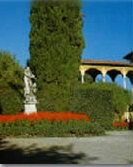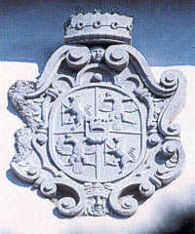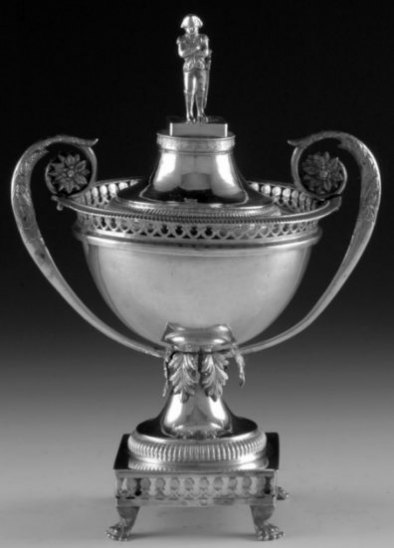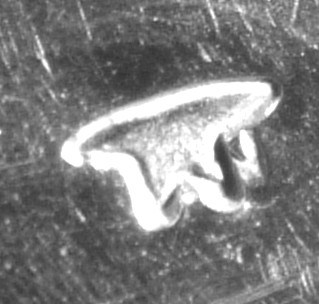click on images to enlarge
A NAPOLEONIC SUGAR BOWL FROM AN ITALIAN MUSEUM
The 'Fondazione Palazzo Coronini Cronberg' of Gorizia (Italy)
Originally constructed in the immediate north-western periphery of
the town, today Villa Coronini Cronberg is in the heart of the city of
Gorizia.
Executed probably on a plan by architect Giulio Baldigara at the end of
16th century, on behalf of Carl Zengraf, the residence is characterized
by a massive body developed on three floors with its nineteenth-century
wing and loggia.
Today the Villa Coronini Cronberg is a
relevant cultural entity. not only for the city of Gorizia, but for
the entire Friuli Venezia Giulia Region.
 
The severe facade of the palace finds a number of ornaments in the
porch supported by four 2nd century powerful diorite's columns and
in the airy terrace with two orders of arches. The terrace connects
the villa to the chapel of 17th century where the last descendants
of the counts Coronini Cronberg are buried. Counts Coronini
Cronberg's family line, of Bergamo origin, concluded in September
1990 with the death of count Guglielmo Coronini, a fascinating man
of versatile culture and artistic sensitivity; also a passionate
researcher and collector. He has been a great personage for the city
of Gorizia, distinguishing for artistic and historical preparation
demonstrated in his writings and in the organization of important
displays. |
 Since
1990 the villa and the art collections have been managed by the
Fondazione Palazzo Coronini Cronberg (Palace Coronini Cronberg
Foundation), a private institution created according to his
testamentary will: "the historical and artistic patrimony put
together in the centuries from my family, completed and
reconstructed to my benefit, it does not have to be dispersed, but
to serve to the public enjoyment and the cultural education of the
collectivity" recites a portion of his testament and then continues
"the palace Coronini Cronberg with the annexed chapel (...) with all
its furnishing, pictures, sculptures, archives, library and
collections (...) with the park (...) will be an intangible and
unalterable museum accessible to the public on perpetual remembrance
of my family and as ornament and attraction of my city." Since
1990 the villa and the art collections have been managed by the
Fondazione Palazzo Coronini Cronberg (Palace Coronini Cronberg
Foundation), a private institution created according to his
testamentary will: "the historical and artistic patrimony put
together in the centuries from my family, completed and
reconstructed to my benefit, it does not have to be dispersed, but
to serve to the public enjoyment and the cultural education of the
collectivity" recites a portion of his testament and then continues
"the palace Coronini Cronberg with the annexed chapel (...) with all
its furnishing, pictures, sculptures, archives, library and
collections (...) with the park (...) will be an intangible and
unalterable museum accessible to the public on perpetual remembrance
of my family and as ornament and attraction of my city."
|
The high value of the collections is testified also by the remarkable
interest manifested by researchers and tourists who from 1992 have
visited the dwelling that preserves its original furnishings. Between
the rooms (mainly furnished in 17th century taste), there are the
'Venetian lacquer' lounges and the Room of Carl X, where on 6 November
1836, Carl X, the last king of France, guest of Count Coronini during
his long wandering after exile from his country, died.
In its rooms you may admire furniture in ebony and turtle, ivory and
lapis lazuli, gilded mirrors, objects of Chinese taste and paintings of
old masters like Titian, Tintoretto, Rubens, J. Van Ruysdael and other
important painters of the 17th and 18th century like Bernardo Strozzi,
Vittore Ghislandi, Alessandro Magnasco, Rosalba Carriera and Antonio
Joli. There are also representatives of the 19th century painting in
Italy (Pompeo Mariani, Guglielmo Ciardi, Angelo Inganni, Antonio Rotta),
Austria (A. Hans Schram, J. Mathias Trenkwald) and France (Leon Richet
and Eugene Boudin). Between the decorative arts there are precious
chinas of Vienna, Capodimonte and Meissen; laces, ancient dresses, arms,
carpets, silver items, glasses and crystals, coins and medals,
archaeological finds, clocks and jewels, designs and prints (between
which Rembrandt, Durer, Titian, Callot, Rosa, Bartolozzi and van
Leyden).
The archival patrimony is composed of thousands of documents ranging
from the 13th to 20th century such as the library, composed of precious
volumes ranging from the 15th to 20th century ('incunaboli', parchments,
manuscripts, 'cinquecentine', 'seicentine' and 'settecentine', books of
medicine and botanic, literature, jurisprudence, history, agronomy and
art, in several languages).
The park in English style of the Coronini villa (nearly 12.5 acres wide)
is open every day from dawn to sunset, free of charges.
BIBLIOGRAPHY ABOUT VILLA CORONINI AND ITS ART'S COLLECTIONS
- clik here -
For informations: Fondazione Palazzo Coronini Cronberg, Viale
XX Settembre 14, 34170 Gorizia ITALY
telephone: (39) 0481/533485, fax (39) 0481/547222
Email:
fondazionecoronini@libero.it
Hourly Offices of Secretary and Direction: from monday to Saturday from
8.00 a.m. to 2.00 p.m.
°°°°°°°°°°°
The Fondazione Palazzo Coronini Cronberg has a collection of
over 500 pieces of Russian, English, German, Austrian, Danish, French
and, obviously, Italian silver from 17th to 20th century.
In preview for ASCAS members Dr.ssa Serenella Ferrari Benedetti,
cultural coordinator and responsible of of the art collections of the
Coronini Cronberg Foundation, presents the description of an interesting
Venetian sugar bowl of the Napoleonic period.
The technical description belongs to the relevant documentation of the
volume
Argenti da Tavola e Posate (Table silver and silverware), series The
collections of the Palazzo Coronini Cronberg Foundation of Gorizia,
catalog to care of C. Bragaglia Venuti, S. Brazza, S. Ferrari Benedetti,
L. Geroni, preface of Angela Griseri, Turin in course of publication
Object: sugar Bowl
Inventory # : 1918 (cup); 3447 (lid)
Author, origin, date: Bartolo Milani; Venice; about 1815
Material, technology: silver embossed; pierced; chiseled; cast
elements
measures: high cm. 16,6 (6 1/2"); wide cm. 15,8 (6 1/4"); Ř cm.
12 (4 3/4"); lid: high cm. 10 (4")
hallmarks:
'earthly Globe with the zodiac and the seven trios' (guarantee
for large items, 2nd purity degree, 800/1000);
'Decoration of stern' (town mark of Venice, capital of the
Department of the Adriatic);
'Anvil' (guarantee for small items, 2nd purity degree, 800/1000);
'Letter M: a point above and a line below (Bartolo Milani
silversmith)'
Bibliography: Ottocento di Frontiera, pp. 219 e 223.
 The sugar bowl has cup's shape with two handles finished with a
flower. The square foot, supported by four lion's feet, is pierced
with little arches and pine's motifs such as on the upper frame
running along the edge of the cup. The foot of the bowl has a
gadrooned edge and is joined to the cup by Acanthus leaves. It rests
on a square base with four lions paw feet. The sugar bowl shows some
Eastern influence in the pierced arches (a decorative solution
typical of contemporary Turkish silverware) and the high level of
craftsmanship of the silversmith.
The sugar bowl has cup's shape with two handles finished with a
flower. The square foot, supported by four lion's feet, is pierced
with little arches and pine's motifs such as on the upper frame
running along the edge of the cup. The foot of the bowl has a
gadrooned edge and is joined to the cup by Acanthus leaves. It rests
on a square base with four lions paw feet. The sugar bowl shows some
Eastern influence in the pierced arches (a decorative solution
typical of contemporary Turkish silverware) and the high level of
craftsmanship of the silversmith.
|
  |
The rubbed silversmith's hallmark created great difficulty before its
attribution to the Venetian silversmith Bartolo Milani, active in the
first decades of the XIX century in San Silvestro 72, Venice.
The lid, in the shape of overturned cup with gadrooned edge and a band
of carved lilies, has an inventory's number different from that of the
sugar bowl as the strict connection between the two objects was
previously unnoted.
In a list of silver compiled by Count Guglielmo Coronini there's the
sugar bowl with no hint to the lid - 'Empire cup - mark: globe with
stars, comet (Italy 1810/76) Venice idem dg. 23' - which is
associated with another item in the Coronini's collection defining the
figure of Napoleon 'modern'.
This sugar bowl was published for the first time in 1995 and described
as 'lacking the lid usually in the shape of overturned cup' (Ottocento
di Frontiera 1995, p. 223).
Therefore neither the Count Coronini nor the author of the catalog were
aware of the connection between the two objects, so that the lid was
introduced in the catalog of 1995 with an independent card (IDEM, p.
219).
The return of the lid to its 'legitimate proprietor' is now proposed
thanks to the fundamental comparison with the sugar bowl produced by
Bartolomeo Valazza (DONAVER-DABBENE cit., p. 30, fig. 14/f) fully
similar to Coronini's piece with the exception of some small details
like the bunch of flowers as the finial instead of Napoleon's figure.
This Napoleon finds an interesting affinity in his pose with the bronze
figure of the French general acting as the handle of an opaline glass
bell preserved to the Palazzo d'Arco of Mantua (Ivi cit., p. 29).
Serenella Ferrari Benedetti - 2004 -
|






